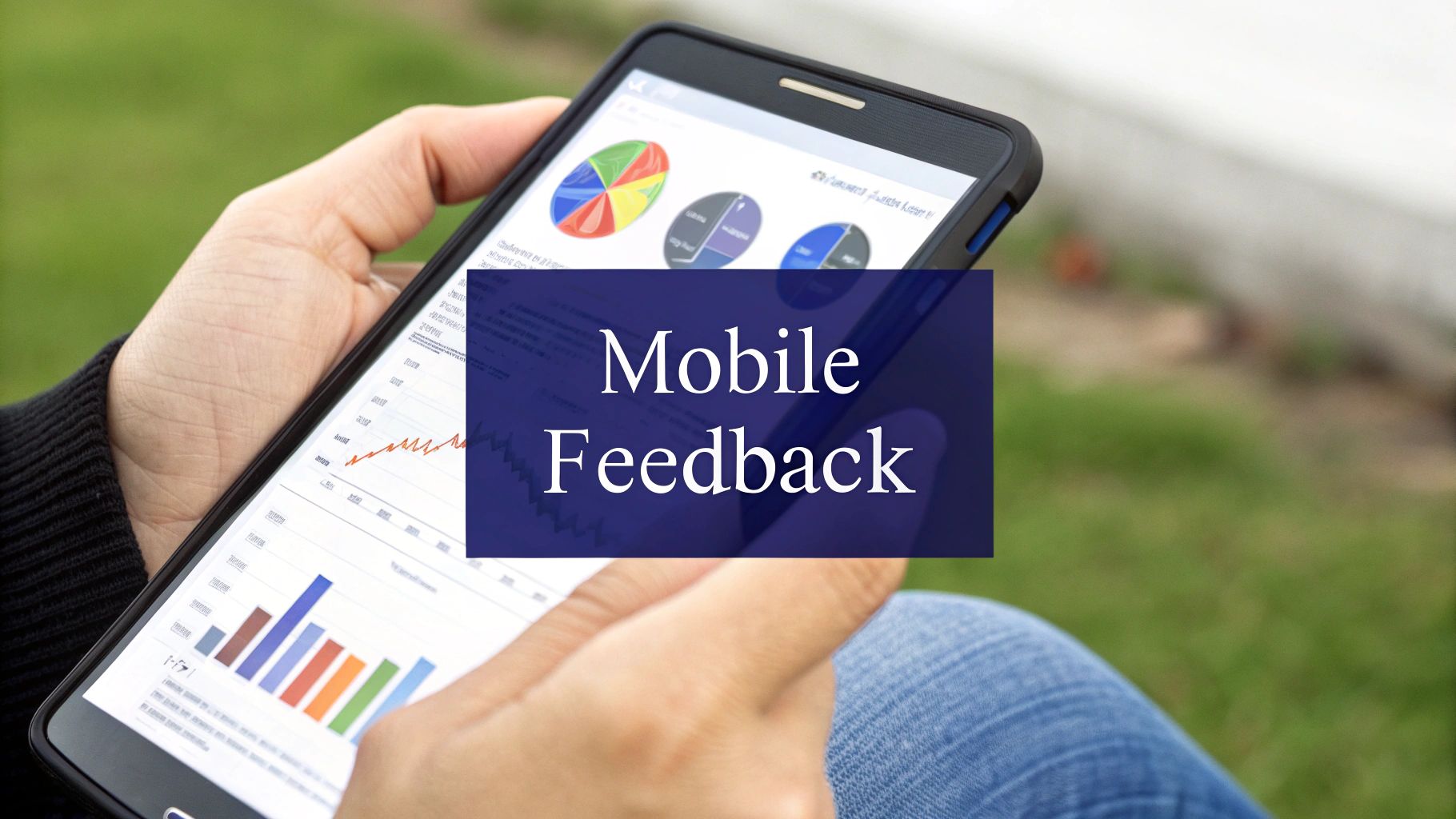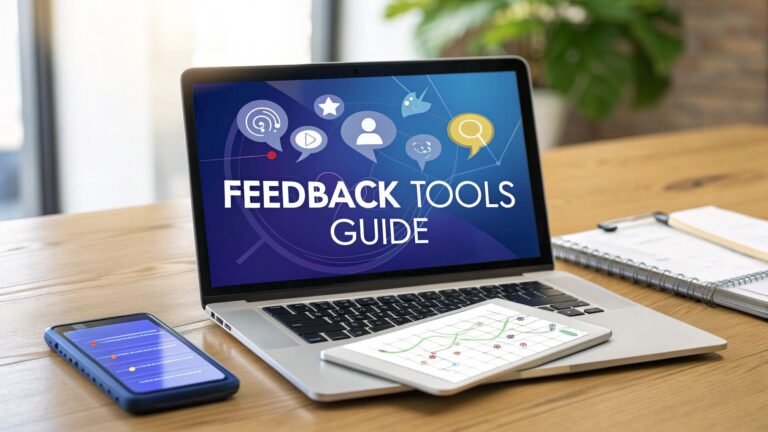Mastering Modern Enterprise Feedback Management
Successful businesses recognize that enterprise feedback management (EFM) is essential for driving growth. What was once basic survey collection has grown into an integrated system that guides decision-making across organizations. Companies getting the best results make feedback a core part of their daily operations rather than just a reactive tool. This empowers them to spot emerging trends and quickly adapt to changing customer preferences.
The Power of Proactive Feedback
Smart organizations prioritize EFM because it gives them direct access to customer perspectives. Consider a software company launching a new feature – instead of discovering issues after release through negative reviews, effective EFM enables real-time feedback during beta testing. This leads to quick adjustments and better customer satisfaction at launch. EFM also provides critical insights into employee experiences, helping identify internal challenges and build a stronger workplace culture. When done right, this creates ongoing improvement that boosts both employee engagement and business performance.
From Data to Actionable Insights
The real value of EFM comes from turning feedback into actionable intelligence that drives decisions. Modern EFM systems use advanced analytics and AI to analyze customer sentiment and identify meaningful patterns in the data. Yet the human element remains key – experts must interpret the findings and translate them into strategic plans. By combining technology with human insight, organizations can uncover the root causes behind customer behaviors.
The Growing Importance of EFM
More companies are investing in EFM as customer experience becomes central to business success. The global EFM market is set to grow from USD 2,677.5 million in 2024 to USD 14,096.8 million by 2034, with a strong Compound Annual Growth Rate (CAGR) of 18.1%. Learn more about the EFM market forecast. These numbers show how important customer feedback has become. Having robust EFM systems is now essential for companies aiming to thrive. As customers demand better experiences, EFM will only grow more vital for guiding business strategy and fueling sustainable growth.
Building Your EFM Success Framework

Creating real business value through enterprise feedback management (EFM) requires more than just collecting surveys. It demands a thoughtful approach focused on driving meaningful improvement. Leading companies build feedback systems strategically by connecting data collection, analysis, and action in ways that deliver clear results.
Here's a breakdown of the key elements that make EFM work successfully along with practical guidance on implementation.
Key Components of a Successful EFM System
Let's first examine how different EFM components work together and compare their business impact:
| Component | Primary Function | Business Impact | Implementation Complexity |
|---|---|---|---|
| Centralized Data Hub | Unified feedback collection | Complete view of sentiment | Medium |
| Analytics Framework | Trend identification | Data-driven decisions | High |
| Insights & Reporting | Action planning | Clear improvement paths | Medium |
| Closed-Loop System | Response management | Increased trust | Low |
| Organizational Support | Change management | Sustained adoption | Medium |
Each of these elements plays a vital role in creating an effective feedback program:
-
Centralized Data Collection: Build a single source of truth for all feedback to prevent silos and gain complete visibility.
-
Robust Analytics: Use advanced tools to spot key patterns and opportunities in large feedback datasets.
-
Action-Focused Reporting: Create clear, focused reports that drive real changes based on feedback insights.
-
Closed-Loop Process: Show customers and employees you're listening by responding to feedback and communicating actions.
-
Company-Wide Support: Get everyone engaged through clear goals, benefits, and training on feedback tools.
Implementing EFM for Maximum Impact
Start with clear objectives – what specific outcomes do you want from your EFM program? Use these goals to select the right tools and approach. Consider rolling out changes gradually to minimize disruption and allow for adjustments. You might find it helpful to review: How a feedback tool helps product managers share feedback quickly across teams.
Overcoming Common EFM Challenges
Two major hurdles often derail EFM programs: lack of employee buy-in and failure to act on feedback. Without clear value and visible follow-through, participation drops and programs stall. The growing investment in this space shows its importance – the EFM software market stands at USD 15.42 billion in 2024 and is expected to reach USD 23.39 billion by 2031. See more details here.
By focusing on these core components and actively addressing challenges, companies can build feedback systems that consistently improve customer satisfaction, employee engagement and overall performance. The key is creating a culture where feedback drives positive change throughout the organization.
Technology Advances in Feedback Management

Smart feedback tools are changing how companies understand and act on customer input. Modern enterprise feedback management (EFM) goes far beyond simple surveys, using powerful technology to create ongoing conversations that drive real improvements.
AI Analysis Provides Deeper Understanding
Artificial intelligence is revolutionizing feedback analysis. AI tools can process huge amounts of customer comments to spot hidden patterns and emotional responses that humans might miss. For example, when analyzing open-ended survey answers, AI categorizes common themes and gauges customer feelings about specific products. This helps companies precisely target improvements and create more personal customer experiences.
Quick Response Times Matter
Today's EFM systems process feedback instantly, so companies can fix problems before they grow. This quick response is crucial for handling negative reviews and complaints right away. The instant data also shows if recent changes are working, helping businesses adapt fast and stay ahead. Companies that respond quickly to feedback build stronger customer loyalty.
Looking Ahead with Smart Predictions
Modern feedback tools don't just look back – they help predict what customers will want next. Predictive modeling uses AI and machine learning to spot upcoming trends and customer needs early. This foresight helps shape better products and marketing plans. The EFM platform market shows how important these tools have become – valued at USD 2.1 billion in 2023, it's expected to reach USD 9.1 billion by 2030, growing at 24.1% yearly. Learn more about the market growth here.
Picking the Right Feedback Tools
When choosing EFM technology, focus on these key features:
- Scalability: The system should easily handle more feedback as you grow
- Integration: It must work smoothly with your existing business tools
- Customization: You need flexibility to match your specific processes
- User-Friendly Design: Both staff and customers should find it easy to use
By carefully selecting tools with these features, companies can build stronger customer relationships through better feedback management. The right system helps turn customer input into real business growth.
Measuring and Maximizing EFM Investment Returns
Want to get real value from your enterprise feedback management (EFM) investment? You need more than just feedback collection – you need a solid framework to measure impact and prove ROI. Here's how to make it happen.
Key Metrics for EFM Success
To properly evaluate your EFM program's performance, focus on these three essential metric categories:
-
Operational Metrics: Track how EFM improves your daily operations. Look for reduced support tickets, faster issue resolution times, and improved feedback routing efficiency. These metrics show tangible gains in service delivery.
-
Financial Metrics: Connect feedback to your bottom line. Monitor increases in customer lifetime value and conversion rates from product improvements driven by feedback. This ties EFM directly to revenue growth.
-
Experiential Metrics: Measure the human impact. Rising customer satisfaction (CSAT) scores demonstrate better experiences. Higher employee engagement shows your internal feedback processes build a stronger culture.
By tracking all three areas, you'll get a complete picture of how EFM creates value across your organization.
Building Your EFM ROI Dashboard
Create a central dashboard to monitor these key performance indicators over time. This helps you spot trends, identify improvement areas, and showcase EFM's value to decision makers.
| Metric Category | Key Indicators | Measurement Method | Target Range |
|---|---|---|---|
| Operational | Reduction in support tickets | Track ticket volume before and after EFM implementation | 10-20% reduction |
| Operational | Improved resolution time | Measure average time to resolve customer issues | 15-25% improvement |
| Financial | Increased customer lifetime value | Analyze customer spending patterns over time | 5-10% increase |
| Financial | Higher conversion rates | Track conversion rates for key actions | 2-5% improvement |
| Experiential | Improved CSAT scores | Conduct regular customer satisfaction surveys | 5-10 point increase |
| Experiential | Increased employee engagement | Measure employee engagement through surveys and feedback tools | 10-15% improvement |
Communicating EFM Value to Stakeholders
To maintain support for your EFM program, you must clearly show its impact. Share concrete examples and data with stakeholders at every level. Use clear visuals and brief reports from your dashboard to highlight how feedback improves key business metrics.
For instance, share the story of how customer feedback led to fixing a confusing checkout flow, resulting in a 5% jump in conversions. Or explain how acting on employee input boosted morale and reduced turnover. Real examples like these make EFM's value clear and compelling, helping secure continued investment in your feedback initiatives.
Creating Customer-Centric Feedback Loops

Smart companies are changing how they work with customer feedback by implementing enterprise feedback management (EFM). The goal is simple – build systems that make customers happier while gathering insights that help the business grow. This creates an ongoing process of improvement that builds stronger customer relationships.
Mapping the Customer Journey With EFM
To make EFM work, you need to understand your customer's journey. Journey mapping shows every interaction customers have with your business, from first discovering you to becoming a loyal customer. This helps identify the perfect moments to ask for feedback. For instance, getting input right after a support call can spotlight ways to improve your service. By targeting feedback at key moments, you ensure you're getting useful insights at each stage.
Analyzing Touchpoints for Deeper Insights
Looking closely at specific touchpoint interactions helps determine which moments matter most for customer satisfaction. Take software onboarding – a smooth start can make or break the whole customer experience. When you know which touchpoints have the biggest impact, you can focus your efforts on improvements that really move the needle.
Creating Meaningful Dialogue With Customers
Good feedback management isn't just data collection – it's about real conversations with customers. Show them you're listening by responding to concerns and acting on their input. When someone leaves a negative review, a thoughtful response shows you care about making things right. Being proactive about asking for feedback through surveys demonstrates your commitment to improvement. Want to learn more? Check out How to master effective feedback loops.
Building Feedback Loops That Drive Continuous Improvement
The power of EFM comes from creating feedback loops that fuel ongoing progress. This means taking what customers tell you and making real changes – from small product tweaks to major service overhauls. The key is having a system to consistently review feedback and take action. When customers see their input leading to concrete improvements, it builds trust and loyalty. By making feedback a core part of how you operate, you create experiences that keep customers coming back and help your business thrive.
Shaping the Future of Enterprise Feedback

Getting feedback from customers is more important than ever before. Enterprise feedback management (EFM) helps businesses understand what customers want and need. Smart companies are already preparing for what's coming next in this critical area.
New Directions in Feedback Management
Several major changes are happening in how companies handle feedback. Real-time feedback is becoming essential – customers want quick responses when they share their thoughts. Companies are using AI and machine learning to analyze feedback more deeply and spot patterns. There's also more focus on sharing feedback across departments to get a complete picture of the customer experience.
Game-Changing Tools for Better Feedback
New technology is making feedback more powerful than ever. Natural language processing (NLP) helps companies understand the emotions and hidden meanings in customer comments. Advanced data visualization makes it easy to spot important trends in feedback data. With these tools, companies can make smarter decisions based on what customers are really saying.
Modern Best Practices for Getting Feedback
The ways companies collect feedback are changing fast. Leading businesses now use in-app feedback widgets and interactive polls to gather insights right when customers are using their products. They also focus on responding to feedback quickly – showing customers their input matters and leads to real improvements.
Creating Systems That Grow With You
To succeed with feedback today, you need systems that can adapt as your needs change. This means picking tools that work well with your other business software. It also means creating a company culture where everyone values and acts on customer feedback. When you build flexibility into how you handle feedback, you're ready to take advantage of new opportunities as they come up.
Ready to make feedback work better for your business? Try BugSmash today! Get started with BugSmash now!




